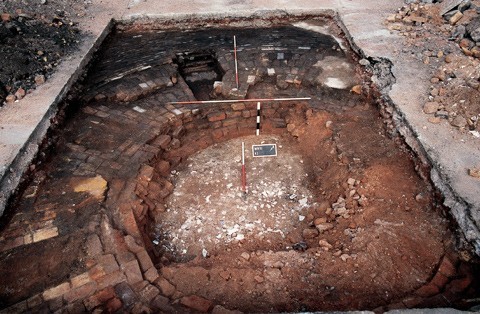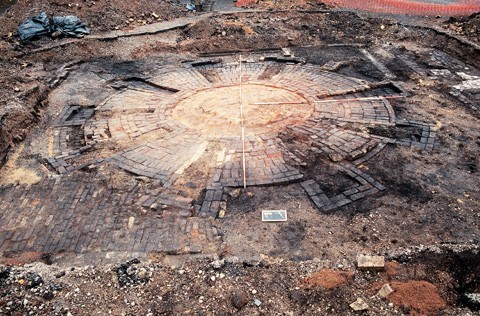
Excavated nineteenth-century oven base from Thomas Minton’s chinaworks. Scales are 0.5, 1.0, and/or 2.3 m. (All photos, The Potteries Museum and Art Gallery, Stoke-on-Trent.)

Mid- to late-nineteenth-century oven base from George Jones’s Trent Potteries. Note the central void.

Detail of central void, showing fill of brick, sandy material, and pottery waste: Sandeman’s “cork.”

Another oven from the Trent Potteries, once again showing the central void.
Recent excavations by Stoke-on-Trent Archaeology Service on the site of the Minton pottery factory have offered new insights into the methods employed in the construction of nineteenth-century pottery kilns. The project unearthed the remains of four “bottle”-shaped updraft kilns ranging in date from the mid-nineteenth to the early twentieth centuries, almost doubling in a stroke the total number of nineteenth-century kilns excavated to date at Stoke-on-Trent.
The site has been home to the present works since the 1950s, but throughout much of the nineteenth and early twentieth centuries the area was occupied by two potworks. The first of these, located in the southwestern corner, was a chinaworks established by Thomas Minton in the late eighteenth or early nineteenth century. In the eastern half of the site, separated from Minton’s works by the Newcastle canal, was the Trent Potteries, erected by George Jones in 1864–1865.
The earliest and most complete of the four kilns found during the service’s excavations formed part of Minton’s chinaworks and was thought to date to the mid-nineteenth century. The base of the oven, discovered at the level of the ash pits, was located within a rectangular room (fig. 1). This indicates that the kiln did not have a separate hovel, but that the hovel was built on the shoulders of the oven chamber and projected through the roof of the building. It is not known whether this was a biscuit or glost kiln.
The three remaining excavated kilns related to George Jones’s Trent Potteries and dated from the late nineteenth to the early twentieth century. Again, each kiln survived as an oven base situated within a rectangular or square room. All were of identical construction: the foundation of the oven was built rather like a brick donut with a core of bricks and waste sherds in the central void (figs. 2-4). The brick surface that formed the bottom of the flues and provided the base for the oven chamber itself was laid over the rubble core. This was something of a revelation, as it had been previously thought that kiln foundations were entirely of brick. Initially it seemed odd that a manufacturer would risk building such an essential part of the factory’s operation on seemingly flimsy foundations. However, subsequent research has shown this to be a recognized practice and one that was entirely sensible.
In his 1901 Notes on the Manufacture of Earthenware, Ernest Albert Sandeman describes a similar construction method in which a foundation—known as the “cork” and composed of broken bricks, “grog” or ground-up saggars, and sherds—was used to form the base of the oven.[1] According to his account, three or four feet of soil were removed and filled with the cork material, which was then raised to the required height and the top graduated from side to center to match the required pitch of the flues. When complete, the cork was smoothed over with a layer of fine, fired sand that acted as a bed for the brick floor subsequently laid on top. It is not clear from Sandeman’s account whether the cork was enclosed by a built outer brick ring, but he does state that the outer circles of the cork should comprise whole bricks to prevent subsidence caused by the oven sucking moisture from the soil beneath it during firing. All of the material used to form the cork was prefired and contained no moisture, thereby negating the costly problem of subsidence, which causes the kiln to list and crack its flues.
This is the first time that we have encountered this construction method archaeologically and recognized it for what it is, and future kiln excavations will no doubt show how widespread this practice actually was. Clearly, however, there is much to learn about these once commonplace structures.
Jonathan Goodwin
Assistant Field Archaeologist
Stoke-on-Trent Archaeology Service
The Potteries Museum & Art Gallery
<jon.goodwin@stoke.gov.uk.>
Ernest Albert Sandeman, Notes on the Manufacture of Earthenware (London: H. Virtue & Co., 1901), pp. 193–95.
